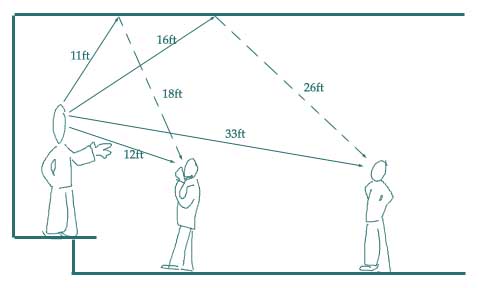
(http://www.ebicom.net/~tct/Images/ampitheatre.gif)
|
(http://www.ebicom.net/~tct/Images/ampitheatre.gif) |
The Greeks had the idea, way back in the day. They placed their theatres on steep hillsides and quiet rural locations, trying to avoid gusty winds as well as urban noise. The circular seating plan allowed more of the audience to be closer to the stage, the actors. Raising the seats in the back allowed all the audience to hear the actors with increased clarity than before. Still this can be improved upon heavily using up-to-date production techniques. |
There are three basic uses of the reflectivity of sound in a room acoustics
environment :
 |
Reflection : Reflection is obviously the return of a sound wave from a surface. If the surface is large compared with the wavelength of the sound, then the angle of the reflected wave will equal the original angle of incidence. For example, we have a sound wave of say 1000Hz and our wall is 4 feet long. 1000Hz corresponds to a wavelength of about 1 ft, so a 4ft long wall will easily reflect the given sound wave (and any with frequencies higher than 1000hz, for their wavelengths grow smaller the larger the frequency) |
 |
Diffusion : Diffusion occurs when the wavelength is equal to the surface that reflects it. Diffusion is the scattering of a sound wave from a surface. Typically surfaces will make up a continuous surface, but will connect with each other at shallow angles to 'break up' sound evenly. This is optimal when there is a large area of sound producers and you want each one to sound amongst the others in all corners of the room. Whereas if you have a single performer an angled reflective surface will be most useful. |
 |
Diffraction : Diffraction is the bending of a sound around an object. This occurs when the reflecting surface is smaller than the wavelength of the reflected wave. Typically these surfaces will be spaced out so that some of the sound goes 'through' them. |
After these, angles and the dreaded trigonometry come into play. A flat reflector
huge from the ceiling with no angle will simply reflect sound waves evenly to
an entire audience, which is nice, but can be improved upon. If we were to angle
the reflector at a convex angle (to the perspective of the speaker) then the
sound energy is distributed for a better listening experience for those in the
back. The converse of this example, were we to have a concave reflector, would
focus sound energy on a specific area, which would not be good for people outside
said area and would cause echoes as well.
 |
A rough way of finding if a room will echo or not is using a ray-diagram
analysis. By charting sound wave rays from speaker to listener in key
points around the room, one will be able to tell if a room will have a
strong echo or not.
|
Since our largest number is 17ft, we are under 28 and excellent for speech.This particular example only works for situations where there is one origin of noise - in multiple origin contexts, such as a meeting/board room, the entire room must be optomized for participants to be able to hear a speaker from anywhere in the room Or for our dance club, where speakers are placed everywhere in the room.
Now that we have a working knowledge of how the shape of the structure affects
acoustics, we can work on...
Designing a quality Concert Hall